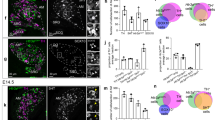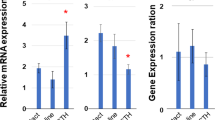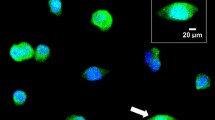Abstract
THE mammalian adrenal gland consists of two anatomically distinct regions; the inner medulla composed largely of catecholamine-producing chromaffin cells, and the outer cortex containing cells that secrete steroid hormones. Although these two adrenal components are derived from different primary germ layers, they come into close contact during embryonic life through an unusual process of tissue migration. Adrenaline is formed in the adrenal medulla through the N-methylation of noradrenaline1. This process is catalysed by an enzyme, phenylethanolamine-N-methyl transferase (PNMT), which is highly concentrated in adrenal chromaffin cells2 and also present in several areas of the brain3. PNMT activity is stimulated in the rat4–6 and the dog7 by hormones secreted from the anterior pituitary gland and the adrenal cortex.
This is a preview of subscription content, access via your institution
Access options
Subscribe to this journal
Receive 51 print issues and online access
$199.00 per year
only $3.90 per issue
Buy this article
- Purchase on Springer Link
- Instant access to full article PDF
Prices may be subject to local taxes which are calculated during checkout
Similar content being viewed by others
References
Kirshner, N., and Goodall, M., Biochim. Biophys. Acta, 24, 658 (1959).
Axelrod, J., J. Biol. Chem., 237, 1657 (1962).
Pohorecky, L. A., Zigmond, M. J., Karten, H. J., and Wurtman, R. J., Fed. Proc., 27, 239 (1968).
Wurtman, R. J., and Axelrod, J., Science, 150, 1464 (1965).
Wurtman, R. J., and Axelrod, J., J. Biol. Chem., 241, 2301 (1966).
Wurtman, R. J., Endocrinology, 79, 608 (1966).
Wurtman, R. J., Casper, A., Axelrod, J., and Bartter, F., J. Clin. Invest., 46, 1135 (1967).
Bush, I. E., J. Endocrinol., 9, 95 (1953).
Lin, E. C. C., and Knox, W. E., J. Biol. Chem., 233, 1186 (1958).
Feigelson, P., Dashman, T., and Margolis, F., Arch. Biochem. Biophys., 85, 478 (1959).
Coupland, R. E., The Natural History of the Chrormffin Cell, 116 (Longmans, 1965).
Moscona, A. A., and Piddington, R., Science, 158, 496 (1967).
Green, W. L., and Ingbar, S. H., Arch. Internal Med. (Chicago), 108, 945 (1961).
Daughaday, W. H., in Textbook of Endocrinology (edit. by Williams, R. H.), chap. 2 (W. B. Saunders, 1962).
Author information
Authors and Affiliations
Rights and permissions
About this article
Cite this article
POHORECKY, L., WURTMAN, R. Induction of Epinephrine-forming Enzyme by Glucocorticoids: Steroid Hydroxylation and Inductive Effect. Nature 219, 392–394 (1968). https://doi.org/10.1038/219392a0
Received:
Revised:
Published:
Issue Date:
DOI: https://doi.org/10.1038/219392a0
Comments
By submitting a comment you agree to abide by our Terms and Community Guidelines. If you find something abusive or that does not comply with our terms or guidelines please flag it as inappropriate.



